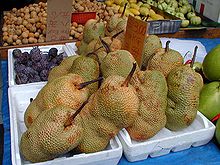- Artocarpus integer
-
Artocarpus integer 
Scientific classification Kingdom: Plantae (unranked): Angiosperms (unranked): Eudicots (unranked): Rosids Order: Rosales Family: Moraceae Tribe: Artocarpeae Genus: Artocarpus Species: A. integer Binomial name Artocarpus integer
Spreng.Synonyms - Artocarpus champeden (Thunb.) Merr.
- Artocarpus polyphema Pers.
Artocarpus integer, known as Chempedak, chempedek or cempedak (pronounced "chem-pe-dak"), is a species of tree and its fruit in the family Moraceae. It is native to southeast Asia(Indonesia), occurring from Indonesia, Malaya Peninsula to the island of New Guinea/Papua. It has been introduced to Queensland. The vigorously growing, medium-sized tree can bear heavy crops of fruit once or twice a year. There are many varieties, although few are named. The sausage-shaped fruits range from 22 to 50 centimetres in length and 10 to 17 cm across. The edible arils surrounding the large seeds are yellow, orange or green in colour. The taste of the fruit is similar to the related Jackfruit and Breadfruit with a hint of Durian. The sweet, juicy pulp surrounds the seeds in a thick layer between the husk and an inedible core. The green skin is thin and leathery, patterned with hexagons that are either flat or raised protuberances like jackfruit skin. The fruit is very popular in its native area, and is becoming so in Queensland. Fritters made by dipping arils in batter and frying in oil are sold in the streets of Malaysia.This is also grown and eaten in Andhra pradesh, Tamil Nadu and Kerala states of India. This is known as "Panasapandu" in Telugu and "Chakka" in Malayalam. Cempedak fruits can be also found and bought in Singapore. The seeds can be boiled and then peeled and eaten. They taste very much like water chestnuts.
See also
- List of fruits
External links
For more information, see "Fruits of the Future: Chempedak" by David K. Chandlee [1]

This Moraceae article is a stub. You can help Wikipedia by expanding it.


